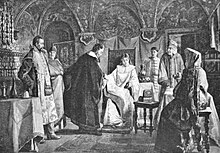Maria Ivanovna Khlopova
You can help expand this article with text translated from the corresponding article in Russian. (January 2014) Click [show] for important translation instructions.
|

Maria Ivanovna Khlopova, known briefly as Anastasia Ivanovna Khlopova (died 1633),[1] was a Russian noble, the fiancée of Tsar Michael I of Russia.[2]
Maria Ivanovna Khlopova was chosen as a potential bride via a brideshow in 1616, and was brought to live amongst the court, as were her grandmother and aunt.[3] However, despite the Tsar's fondness for Maria, his mother did not like her or her family, and wished for her son to marry one of her own relatives.[4]
During one court function Maria - who had been given the name Anastasia upon coming to court - vomited, collapsed, and soon became violently ill.[4] This caused whispers throughout the court that, despite her apparent good health during the brideshow, she must be inherently ill, and thus likely unfit to bear children for the Tsar.[5] However the truth was that she had simply eaten too many sweets in the Tsar's decadent palace.[6] Some suspected she had been poisoned, which was a great fear in Russian court at the time.[7] Khlopova was put in the care of Mikhail Saltykov, Maternal cousin of the Tsar, and strong opponent to Maria's ascension. Saltykov dosed her with potions from the pharmacy causing her to become even moire ill. Maria's illness was cited as proof of inability to bear children[2] and she and her family were exiled to Siberia, though her father was later appointed governor of Vologda. The Tsar, who had allegedly become very close to Maria during her six-week stint as Tsarina, swore never to wed.[8]
Even years after she was exiled, Tsar Michael wished to make her his wife.[9][6] He rejected other potential marriage matches, and finally managed to convince his father, Patriarch Filaret, who had just returned from imprisonment in Poland, to consider Maria again.[10] Filaret sent doctors to investigate and examine Maria in her exile, and they found her to be completely healthy.[8] Filaret and Michael were astounded, and, demanding to know why they had been told Maria suffered from a chronic illness, began a larger inquiry. On further interview, Maria testified that she had vomited only once, until Saltykov had administered a medicine, which caused her extreme sickness.[8]
The Saltykovs barely escaped with their heads, banished.[11] Though Michael hoped he would now be able to marry Maria, his mother still refused to permit it.[6] He was forced to choose another bride, and he married Maria Dolgorukova in 1624.[8]
References
[edit]- ^ Solovʹev, Sergeĭ Mikhaĭlovich (1976). History of Russia. Academic International Press. ISBN 978-0-87569-149-7.
- ^ a b Kivelson, Valerie A. (2013-11-15). Desperate Magic: The Moral Economy of Witchcraft in Seventeenth-Century Russia. Cornell University Press. ISBN 978-0-8014-6937-4.
- ^ Solovʹev, Sergeĭ Mikhaĭlovich (1976). History of Russia: The first Romanov : Tsar Michael, 1613-1634. Academic International Press. ISBN 978-0-87569-066-7.
- ^ a b Martin, Russell E. (2012-06-15). A Bride for the Tsar: Bride-Shows and Marriage Politics in Early Modern Russia. Cornell University Press. ISBN 978-1-5017-5665-8.
- ^ Bushkovitch, Paul (2001-09-27). Peter the Great: The Struggle for Power, 1671–1725. Cambridge University Press. ISBN 978-1-139-43075-3.
- ^ a b c Montefiore, Simon Sebag (2016). The Romanovs: 1613-1918. Alfred A. Knopf. ISBN 978-0-307-26652-1.
- ^ Griffin, Clare (2022-09-15). Mixing Medicines: The Global Drug Trade and Early Modern Russia. McGill-Queen's Press - MQUP. ISBN 978-0-2280-1284-9.
- ^ a b c d Grey, Ian (2016-04-13). The Romanovs. New Word City. ISBN 978-1-61230-954-5.
- ^ Martin, Russell E. (1999). "Gifts for the Dead: Death, Kinship and Commemoration in Muscovy (the Case of the Mstislavskii Princes)". Russian History. 26 (2): 171–202. doi:10.1163/187633199788163668. ISSN 0094-288X. JSTOR 24659346. PMID 22462188.
- ^ Shcherbachev, Oleg V. (2016-01-02). "The Kinship Between the Saltykovs and Mikhail Fedorovich Romanov". Russian Studies in History. 55 (1): 76–82. doi:10.1080/10611983.2016.1194649. ISSN 1061-1983. S2CID 164073655.
- ^ Keep, J. L. H. (1960). "The Régime of Filaret 1619-1633". The Slavonic and East European Review. 38 (91): 334–360. ISSN 0037-6795. JSTOR 4205172.
Bibliography
[edit]- П. Мельников. «Мария Ивановна Хлопова, невеста царя Михаила Федоровича» ("Нижегородские Губернские Ведомости", 1845, № 7 и след.)
- Д. Мордовцев. «Русские женщины допетровской Руси»;
- И. Е. Забелин. «Домашний быт русских цариц» (глава 3-я).
